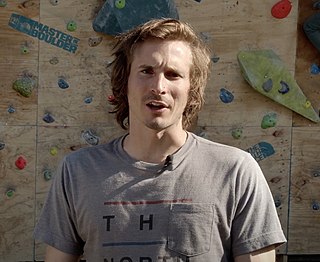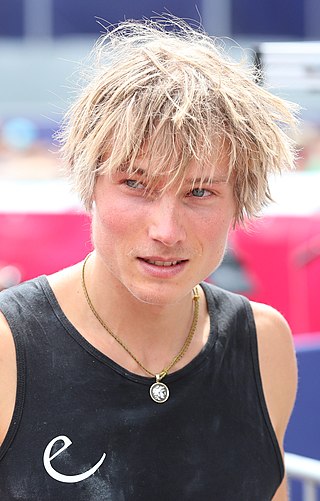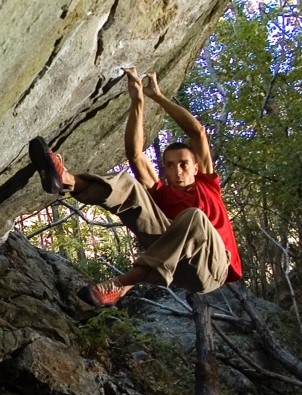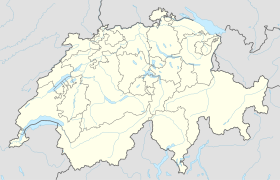
David Ethan Graham is an American professional rock climber. Professing to enjoy bouldering the most, he is one of the elite sport climbers and boulderers of his generation. Graham repeats classic routes or boulder problems as well as performing cutting-edge first ascents. He is known for climbing in 2005 an 8C (V15) graded boulder problem called The Story of Two Worlds, in Cresciano, Switzerland). He is also known for his stance against grade inflation and for his strong anti-chipping ethic. He writes an ongoing blog for the website of Climbing Magazine.
Fred Rouhling is a French rock climber and boulderer, noted for creating and repeating some of the earliest grade 9a (5.14d) sport climbing routes in the world, including Hugh in 1993, the first-ever French 9a (5.14d) sport route. Rouhling is also known for the controversy from his proposed grading of 9b (5.15b) for his 1995 route Akira, which would have made it the world's first-ever 9b-graded sport route; 25 years later, it was graded at 9a (5.14d).

Fred Nicole is a Swiss rock climber known for his first ascents of extreme sport climbing routes, and also for pioneering the development of standards and techniques in modern bouldering in the 1990s and early 2000s; he is considered an important climber in the history of the sport.
The Fly is a short 25-foot (7.6 m) schist sport climbing or highball bouldering route in the Rumney Rocks climbing area, New Hampshire, USA, at the Waimea Cliff. The Fly was bolted by Mark Sprague in 1995 as an open project but did not see a first free ascent until David Graham, an 18-year-old American climber from Maine, climbed it in April 2000, who graded it 5.14d (9a) or V14 (8B+). It was quickly repeated by his climbing partner, Luke Parady. At the time, these ascents were milestones for climbing in North America.
Dai Koyamada is a Japanese rock climber and known as one of the leading boulderers of his generation who established some of the first-ever boulder problems at 8C (V15). He has also established and repeated, some of the hardest sport climbs in the world.

The Mandala is a 6-metre (20 ft) high granite bouldering route in the Buttermilks, a popular bouldering area near Bishop, California. Considered a "next generation" problem in the 1970s, the route was first solved by American climber Chris Sharma in February 2000. It is one of the most widely known boulder problems in the world and is graded at V12 (8A+), and the sit start variation is graded at V14 (8B+).
Malcolm Smith is a Scottish rock climber and competition climber who won the bouldering IFSC Climbing World Cup in 2002.

The Wheel of Life is a 21-metre (69 ft) long sandstone bouldering route on the roof of the Hollow Mountain Cave in the Grampians of Australia. When first climbed, it was graded at 8C+ (V16), one of the world's first-ever boulder routes at that grade. With repeats, it was graded at 8C (V15), and some consider it to really be a sport climbing traverse route, at the sport grade of 9a (5.14d).

Ashima Shiraishi is an American rock climber. Shiraishi started climbing at the age of six at Rat Rock in Central Park, joining her father. Only a few years later, she quickly established herself as one of the top boulderers and sport climbers in the world. Her numerous accomplishments include first-place finishes in international competitions, and multiple first female and youngest ascents. Shiraishi is featured in several short documentary-style films, and is the subject of the documentary short "Return to the Red" (2012).

Midnight Lightning is a 7.62-metre (25.0 ft) high granite bouldering route on the Columbia Boulder in Camp 4 of Yosemite National Park. When first solved in May 1978 by American rock climber Ron Kauk, it was graded at V8 (7B/7B+), which was the world's second-ever boulder route at that grade, and the first in North America. Even today, the route is still considered a "hard" V8 grade. Midnight Lightning is the most notable bouldering route in climbing along with Dreamtime, and its ascent is considered an important moment in the history and the development of bouldering as a sport in its own right.

Daniel Woods is an American professional rock climber who specializes in bouldering, and who is considered one of the most important climbers in the history of bouldering. Woods has climbed over thirty boulder problems graded at or above 8C (V15). He has also won several competition bouldering events, such as the U.S. National Bouldering Championship and some international events. In March 2021, Woods achieved the first ascent of a low start to Sleepwalker V16 (8C+) which he named Return of the Sleepwalker and proposed the grade 9A (V17), only the second-ever route in history at that grade.
Jimmy Webb is an American professional rock climber specializing in bouldering. He is one of a handful of climbers who have climbed the boulder grade V16 (8C+).

Alexander Megos is a German rock climber specializing in sport climbing, bouldering and competition climbing. In 2013, he became the first-ever climber to onsight a 9a (5.14d) graded route. He has made the first free ascent (FFA) of some of the hardest sport climbing routes in the world, including two 9b+ (5.15c) routes, four 9b (5.15b) routes, and several boulders with a boulder 8C (V15) rating.

Stefano Ghisolfi is an Italian professional rock climber, who specializes in competition climbing, sport climbing, and bouldering. In competition climbing, he completes in competition lead climbing, competition bouldering, and competition speed climbing, with lead being his strongest discipline. As a sport climber, he has redpointed sport climbing routes of grade 9b+ (5.15c), onsighted routes of 8c (5.14b), and solved boulder problems at grade 8B+ (V14). In December 2018, after climbing Perfecto Mundo, he became the fourth climber in history to redpoint a 9b+ (5.15c) route.

Christian Core is an Italian professional rock climber who specialises in bouldering and competition bouldering. He is known for being the first-ever person in the world to climb an 8C+ (V16) boulder, Gioia, in 2008. As a competition climber, Core won the Bouldering World Cup twice in 1999 and 2002, and also won the Bouldering World Championship in 2003.

Jan Hojer is a German professional rock climber specializing in sport climbing, bouldering, and competition climbing. He is known for winning one World Cup and two European Championships in competition bouldering. In May 2010, he climbed Action Directe, one of the most difficult sport climbing routes in the world. From 2013 to 2015, he sent several 8C (V15) boulder problems.

Hubble is a short 10-metre (33 ft) bolted sport climb at the limestone crag of Raven Tor in Millers Dale, in the Peak District in Derbyshire, England. When Hubble was first redpointed by English climber Ben Moon on 14 June 1990, it became the first-ever climb in the world to have a consensus climbing grade of 8c+ (5.14c); and the highest grade in the English system at E9 7b.

William (Will) Bosi is a British professional rock climber specializing in sport climbing, bouldering and competition climbing. Bosi is only the second British sport climber in history to redpoint a 9b (5.15b) graded sport climbing route, and by 2023, was one of only a small group of climbers in the world to have completed a V17 (9A) boulder.

Simon Lorenzi is a Belgian professional rock climber specializing in sport climbing, bouldering and competition climbing. Lorenzi is one of the very few climbers to have repeated a V17 (9A) bouldering route, and the third climber to solve Burden of Dreams, the first-ever V17 (9A) graded boulder route. Lorenzi also made the first ascent of Soudain Seul, a V16/V17 boulder.
















